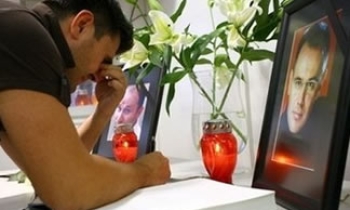The industry has tried to get the word out, but many consumers still aren't getting the message: In a year and a half, millions of television screens could go dark.
Not the fancy high-definition TVs or those connected to cable or satellite. But the 70 million sets relying on rooftop or "rabbit ears" antennas will end up showing nothing but snow.
Broadcasters will stop sending analog signals and move to all-digital programming on Feb. 17, 2009. After that, antenna TV watchers will need a special converter box to watch their sitcoms and newscasts.
But many consumers have no idea that this change is coming, and members of Congress are voicing concern over the lack of cooperation between federal agencies and the entertainment industry.
The political static comes as broadcasters, retailers, cable operators and regulators clash over how to educate consumers about the change. Sales of digital television sets have nearly tripled since 2005, and the Consumer Electronics Association expects annual sales to top $26 billion this year. With the holiday season approaching, government officials in charge of managing the transition to digital TV say that they're severely underprepared and that they worry that the biggest electronics retailers are misinformed.
"If we don't do a better job of planning, we'll have one of the biggest outrages Congress has ever seen," Federal Communications Commissioner Jonathan S. Adelstein told the Senate Special Committee on Aging last week. "This is a huge market opportunity, but also an opportunity for a huge disaster."
Nearly all TV stations air analog and digital programming. But at midnight Feb. 17, 2009, stations will drop the analog signals that have been standard since the dawn of broadcast television in the 1930s. The switch of such a mainstream technology is unprecedented, and it's the biggest change for the broadcast industry since the advent of color television.
The benefit is that digital technology uses airwaves more efficiently, which means the move will free up some radio spectrum for wireless and public-safety communications. The Telecommunications Act of 1996 granted broadcasters free airwaves to carry digital signals with the understanding that once all programming went digital, the old analog airwaves would be put to other use.
Huge corporate interests are now riding on the transition. Broadcasters hope to lure viewers with crisper, sharper pictures and more stations. TV manufacturers and retailers hope to reap bigger profits if consumers opt to buy new televisions instead of modifying their old sets with converter boxes. Cable and satellite TV providers hope to sign new customers by marketing themselves as an alternative to either the converter or a new television.
But regulators fear that a fragmented or misleading education campaign could leave millions of viewers in the dark. Hard-to-reach demographics like elderly, rural or non-English-speaking viewers are at the highest risk of losing the over-the-air signals they rely on for weather, news and emergency information, according to a recent report by the Government Accountability Office.
"There is no one in charge, and that is cause for concern," said Mark L. Goldstein, director of physical infrastructure issues for the GAO. "There is no comprehensive planning effort, and no one is assessing what gaps exist."
Goldstein said the FCC should take the lead in guiding the transition but noted that "there seems to be some confusion" between the FCC chairman, Kevin J. Martin, and other commissioners about the extent of the agency's responsibilities in educating the public. Adelstein acknowledged that the FCC's outreach efforts have been "lackluster at best" and said "there has been a lack of leadership and resources" put toward implementing ideas. The FCC has asked for $20 million for consumer education. The FCC is also considering requiring retailers, manufacturers and service providers to educate consumers.
The commission also ruled this month that cable operators must carry broadcasters' analog signals for three years after the transition, so the 40 million basic, non-digital cable subscribers will still receive broadcast channels.
Congress allocated $1.5 billion to the Commerce Department's National Telecommunications and Information Administration to provide coupons for consumers to purchase digital-to-analog converter boxes. Starting in January, each household can request up to two $40 coupons toward a converter box.
Consumer education has been extensive but disjointed. The NTIA received $5 million for its consumer-education campaign. The FCC launched a Web site, DTV.gov. The DTV Transition Coalition, made up of about 120 public, private and nonprofit groups, is trying to coordinate outreach efforts. And cable operators, broadcasters and the Consumer Electronics Association are beginning to air multimillion-dollar ad campaigns.
In addition, the FCC and the NTIA both held education workshops this week. Sen. Herb Kohl (D-Wis.), chairman of the Special Committee on Aging, this week introduced a bill that would require the two agencies to partner with industry groups on education.
But some lawmakers and consumer advocates say that each campaign carries a different message, further confusing consumers.
A survey last month by the Association of Public Television Stations showed that 51 percent of Americans are still unaware of the transition.
"Congress is in essence expecting the industry players to fund the campaign themselves," said Carol Mattey, director of telecommunications regulatory consulting at Deloitte & Touche. "Any kind of mandate involves costs and affects the bottom line."
Broadcasters stand to lose the most from an ill-informed audience, Mattey said. If viewers wake up next winter to a blank TV screen, broadcasters run the risk of losing advertising dollars.
"The last thing we want is some sort of consumer revolt in 2009 due to lack of information," said Dennis Wharton, spokesman for the National Association of Broadcasters. "Our very business model is at stake here, and we only have one chance to get this transition right."
The NAB estimates that 15 million households have secondary sets that rely on over-the-air signals.
Although TV manufacturers no longer produce analog sets, some retailers are still selling them without warning consumers of their short life expectancy. The FCC issued citations to several hundred stores with potential fines totaling more than $3 million for failing to comply.
In stores run by top retailers like Best Buy and Target, many sales associates provided "incorrect and misleading information" about the digital transition, often telling consumers their only option is to buy a new TV set, according to a survey of Northern Virginia stores by the U.S. Public Interest Research Group.
The finger-pointing could get nasty if the transition doesn't go smoothly, especially since the cut-over date is just after the presidential election, Mattey said. "Will one party be blaming the other for dropping the ball?"









